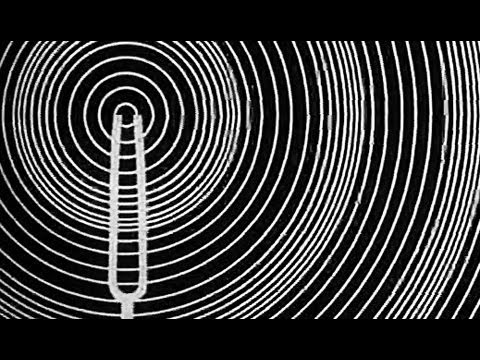more at
“Sources of sounds and characteristics of sound waves, shown by means of oscilloscopes and animated diagrams.”
NEW VERSION with improved video & sound:
Public domain film from the Prelinger Archive, slightly cropped to remove uneven edges, with the aspect ratio corrected, and mild video noise reduction applied.
The soundtrack was also processed with volume normalization, noise reduction, clipping reduction, and/or equalization (the resulting sound, though not perfect, is far less noisy than the original).
Sound is a mechanical wave that is an oscillation of pressure transmitted through some medium (like air or water), composed of frequencies within the range of hearing…
Propagation of sound
Sound is a sequence of waves of pressure that propagates through compressible media such as air or water. (Sound can propagate through solids as well, but there are additional modes of propagation). Sound that is perceptible by humans has frequencies from about 20 Hz to 20,000 Hz. In air at standard temperature and pressure, the corresponding wavelengths of sound waves range from 17 m to 17 mm. During propagation, waves can be reflected, refracted, or attenuated by the medium.
The behavior of sound propagation is generally affected by three things:
– A relationship between density and pressure. This relationship, affected by temperature, determines the speed of sound within the medium.
– The propagation is also affected by the motion of the medium itself. For example, sound moving through wind. Independent of the motion of sound through the medium, if the medium is moving, the sound is further transported.
– The viscosity of the medium also affects the motion of sound waves. It determines the rate at which sound is attenuated. For many media, such as air or water, attenuation due to viscosity is negligible.
When sound is moving through a medium that does not have constant physical properties, it may be refracted (either dispersed or focused).
The mechanical vibrations that can be interpreted as sound are able to travel through all forms of matter: gases, liquids, solids, and plasmas. The matter that supports the sound is called the medium. Sound cannot travel through a vacuum.
Longitudinal and transverse waves
Sound is transmitted through gases, plasma, and liquids as longitudinal waves, also called compression waves. Through solids, however, it can be transmitted as both longitudinal waves and transverse waves. Longitudinal sound waves are waves of alternating pressure deviations from the equilibrium pressure, causing local regions of compression and rarefaction, while transverse waves (in solids) are waves of alternating shear stress at right angle to the direction of propagation.
Matter in the medium is periodically displaced by a sound wave, and thus oscillates. The energy carried by the sound wave converts back and forth between the potential energy of the extra compression (in case of longitudinal waves) or lateral displacement strain (in case of transverse waves) of the matter and the kinetic energy of the oscillations of the medium.
Sound wave properties and characteristics
Sound waves are often simplified to a description in terms of sinusoidal plane waves, which are characterized by these generic properties:
– Frequency, or its inverse, the period
– Wavelength
– Wavenumber
– Amplitude
– Sound pressure
– Sound intensity
– Speed of sound
– Direction
Sometimes speed and direction are combined as a velocity vector; wavenumber and direction are combined as a wave vector.
Transverse waves, also known as shear waves, have the additional property, polarization, and are not a characteristic of sound waves…
Perception of sound
The perception of sound in any organism is limited to a certain range of frequencies. For humans, hearing is normally limited to frequencies between about 20 Hz and 20,000 Hz (20 kHz), although these limits are not definite. The upper limit generally decreases with age. Other species have a different range of hearing. For example, dogs can perceive vibrations higher than 20 kHz, but are deaf to anything below 40 Hz…

